Wheel Building School
"One day with a Teacher is worth a thousand pages"
I teach a one-on-one class for just one student at a time. The class usually lasts for two full days and provides complete instruction on how to build a set of custom bicycle wheels that are planned and designed beforehand through discussions with each student.
A surprising number of people want to learn how to build a bicycle wheel. The reasons are many, from just wanting to become better at using a truing stand to wanting an in-depth understanding of the structure and strength of a wheel. There are many good books about wheel building. I think I have read them all, and I highly value their contribution. But, a book cannot possibly anticipate the questions that will pop up during a wheel building attempt. As a personal instructor, I can fill that need.
By teaching only one student at a time, I've found that I can delve deeply into the specific needs of my students and adjust my approach, as required, depending on their individual backgrounds, interests, and experience. This formula has worked very well, and my students are getting great results. (See the testimonials below).
I like my students to put some effort into learning about wheels before the class begins, and I will provide to them some recommended pre-class material to study. This prepares them for the class and deepens the depth of understanding they will take from the school. I will give them as thorough an education as they reasonably want during the class itself.
Where:
Trek Bikes
1545 North Quaker Lane
Alexandria, VA 22302
When:
This is the easy part. Once we have all the component parts on hand, we find a date that is mutually convenient. I prefer weekdays, especially during the really busy season, but it's possible to hold a class over a weekend if weekdays are impossible.
Costs:
Tuition is $600
Additionally, students must purchase the digital downloadable versions of Master Wheel Building and Master Wheel Building II from this website and prepare for the class by reviewing them beforehand. The cost of purchasing both of these videos together is $49.95, and they are filled with useful information.

Designing the Wheels: In preparation for the school, I work individually with my students to plan out their projects. A face-to-face meeting is helpful, but the same results can be obtained by a combination of emails and phone calls for students who live out of town. Students can build just about any type of wheel they want, consistent with sound engineering principles. Most students buy needed parts from me, but they can acquire some or all of the parts themselves, if they want to.
Component choices Include:
- Hubs - White Industries, Chris King, Velocity, Shimano, Campagnolo, Phil Wood, Paul, Alchemy, Powertap, DT Swiss, Hope, Miche, Salsa, Surly, and more.
- Rims - Velocity, Kinlin, HED, Mavic, H Plus Son, ENVE, Salsa, Stan's, Sun Ringle, DT Swiss, Surly, Boyd Cycling, NOX Composites, and more.
- Spokes: - DT Swiss and Sapim
- Nipples - DT Swiss and Sapim
Tools: All tools are provided, but students may of course elect to purchase their own wheelbuilding tools.
Depending on what components are used, special tools are sometimes required, and it is often critical to use the correct tools. An example would be when building with bladed spokes such as the high-end Sapim CX-Ray spoke. CX-Ray spokes are extraordinarily strong and light. Their airfoil shape also gives them a very low drag coefficient. To avoid inadvertent damage to a spoke when building or servicing a wheel made from Sapim CX-Ray spokes, it is important to use the correct tools. In my school, I teach students the proper techniques to employ with Sapim spokes and also offer the proper tools for sale. I have a Sapim digital tensiometer that is specifically calibrated for use with Sapim spokes, and I have received training on two occasions from Sapim's technical experts at the Antwerp, Belgium factory and headquarters.
Follow-Ups: Former students are welcome to return at any time for any “tweaking” their wheels may need.
Contact me at:
Phone: 703-820-2200
Email: bill@billmouldwheels.com
 "Most of you know, after I retired from the Army last year, I took a year off from traditional employment. It's been an amazing year and at some point I'll journal capturing it. I am ending the year with another terrific experience. I have been fortunate enough to spend a number of hours with a pretty amazing person (Bill Mould) learning a new skill I thoroughly enjoy. Bill is arguably, the planet's expert on all things that make a bicycle wheel go round. (https://billmouldwheels.com/about) I've been so blessed to have rubbed shoulders most of my life with some remarkable people whose expertise in their field is only matched by their humility. If you are in Northern Virginia, swing by Spokes Etc. and say hello to Bill."
"Most of you know, after I retired from the Army last year, I took a year off from traditional employment. It's been an amazing year and at some point I'll journal capturing it. I am ending the year with another terrific experience. I have been fortunate enough to spend a number of hours with a pretty amazing person (Bill Mould) learning a new skill I thoroughly enjoy. Bill is arguably, the planet's expert on all things that make a bicycle wheel go round. (https://billmouldwheels.com/about) I've been so blessed to have rubbed shoulders most of my life with some remarkable people whose expertise in their field is only matched by their humility. If you are in Northern Virginia, swing by Spokes Etc. and say hello to Bill."
- Patty Solimene Collins
"Bill,
If I may, I'd also like to express my appreciation and admiration for the class... I've always been a little intimidated by the idea of building and or truing wheels but you have safely put that to rest. You have both a passionate exuberance and a deep well of patience. A difficult combination. I now look at wheels in a different light because I understand much more about how they work. That you understand so much is well accepted without exception. That you are able to communicate it so effectively is truly exceptional.
I now have 4 sets of wheels. 3 of them still carry me solely because of your efforts. This newest set presented an even greater challenge- you didn't have to fix them- but keep me from breaking them. So far so good- but I am now unsupervised, right?
I am also grateful for your friendship. Beyond our passion for bicycles we share a common professional bond, and that runs deep.
Semper Fidelis,
Don"
- Don (Col Wogaman)
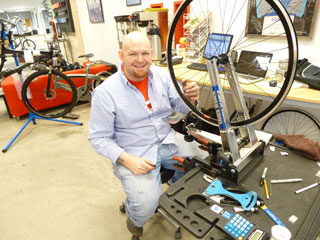 Robie Lutsey, a computer security expert, attended my one-on-one wheel building school in 2013. He built a pair of all-black, bomb-proof wheels using Shimano 105 hubs, Velocity Deep V rims, DT Swiss double-butted spokes, and Sapim Polyax SILS nipples. Both wheels were made with 36 spokes. For quality, strength, and durability, it would be hard to beat that combination.
Robie Lutsey, a computer security expert, attended my one-on-one wheel building school in 2013. He built a pair of all-black, bomb-proof wheels using Shimano 105 hubs, Velocity Deep V rims, DT Swiss double-butted spokes, and Sapim Polyax SILS nipples. Both wheels were made with 36 spokes. For quality, strength, and durability, it would be hard to beat that combination.
"I had a great time meeting Bill, and learning from him. The tutelage ranged from wheel building (obviously) to organic chemistry and leadership. Bill isn't just a great teacher; he's a great guy. Really, the only limit on the curriculum was my own level of curiosity. Bill answered every question, often with a story that included some bonus info too.
On the topic of wheels, I walked away with a pair of supreme wheels that are amazing to ride. I tried them on my rollers so I could really get the measure of them. They were smooth like butter and… I know this sounds like a paid ad, but it's true… my balance felt way better than on my machine wheels. Round and true and my new best friends!
I can't recommend Bill's class enough. Not only will you get new wheels and the skills to maintain and repair them, but you'll leave a better person."
- Robie Lutsey, Fairfax, VA
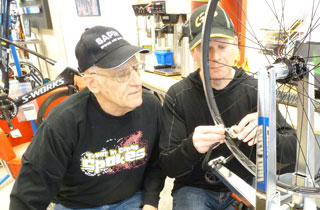 David Hill is a mechanical engineer from Steamboat Springs, Colorado. In my wheelbuilding school, Dave built some really cool, lightweight road bike wheels made from Chris King R45 hubs, HED Belgium rims, Sapim CX-Ray spokes, and Sapim Polyax SILS nipples. To ensure protection of the spokes against accidental twisting, we were sure to use a good spoke holder and a 4-sided Cyclus spoke wrench. I also used my digital Sapim tensiometer to check the final tension for magnitude and consistency. High degrees of radial and lateral true were achieved.
David Hill is a mechanical engineer from Steamboat Springs, Colorado. In my wheelbuilding school, Dave built some really cool, lightweight road bike wheels made from Chris King R45 hubs, HED Belgium rims, Sapim CX-Ray spokes, and Sapim Polyax SILS nipples. To ensure protection of the spokes against accidental twisting, we were sure to use a good spoke holder and a 4-sided Cyclus spoke wrench. I also used my digital Sapim tensiometer to check the final tension for magnitude and consistency. High degrees of radial and lateral true were achieved.
"Thank you very much for the time and valuable insights you provided in our day and a half together building wheels at your school. It far exceeded my expectations and has only served to further increase my curiosity and desire to build my next set of wheels. Your wisdom, depth of understanding and ability to communicate in a clear, logical manner makes the time just fly by. It is also abundantly obvious that you love what you do and it translates so well to your students and to the finished product. It was a great way to stay connected with the bike in the off season and I can hardly wait to put my new wheels to the test this spring."
- David Hill
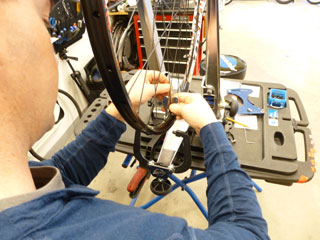 Sam Cordero is a mechanical engineer and active duty Naval officer. In my school, he built two disc wheels using Chris King ISO red hubs, Stan's Arch EX 29er rims, Sapim Polyax SILS nipples, and Sapim Race spokes. I've found that Sapim spokes often work better than DT Swiss spokes with Chris King products because the neck of the Sapim spokes is a fraction of a millimeter longer, and that better allows the heads of the spokes to fit properly into the slightly thicker Chris King flanges. I learned from Sam, too, when he gave me a good understanding of a concept in materials science called "slip planes" and how it relates to stress relieving when building a wheel.
Sam Cordero is a mechanical engineer and active duty Naval officer. In my school, he built two disc wheels using Chris King ISO red hubs, Stan's Arch EX 29er rims, Sapim Polyax SILS nipples, and Sapim Race spokes. I've found that Sapim spokes often work better than DT Swiss spokes with Chris King products because the neck of the Sapim spokes is a fraction of a millimeter longer, and that better allows the heads of the spokes to fit properly into the slightly thicker Chris King flanges. I learned from Sam, too, when he gave me a good understanding of a concept in materials science called "slip planes" and how it relates to stress relieving when building a wheel.
"A few years prior to taking Bill's class, I attempted to build a wheel on my own. I referenced a well-known known book on wheels as well as another well known website. My first attempt was a disaster. It looked fine on the truing stand, but after a few miles it began to loose tension unevenly. In my opinion and the experience I describe, the book and website were inadequate to actually teach one how to build a wheel.
Bill's class is quite the contrary. Instead of waxing philosophically about wheels, Bill is more prone to wax scientifically about building a wheel. If one were to carefully analyze modern bicycle wheel structure, one should arrive at the conclusion that a rotational load bearing assembly should be as uniform in construction as possible. This is where Bill's class really shines. Unlike the book and website, Bill teaches a bullet proof and disciplined method to uniformly establishing initial, intermediate, and final tension in the wheel as well as the secondary parameters of radial and lateral true as well as dish. If you adhere to Bill's process with due discipline (focus without distraction), you will find yourself with a nicely hand built custom wheelset that delivers on the tradeoffs of cost, strength, and weight to your own choosing. You will also know that for the cost and weight you choose, your wheel will be stronger than a machine built wheel given the same tradeoff in cost vs weight. It certainly worked out that way for me."
- Sam Cordero, Alexandria, VA
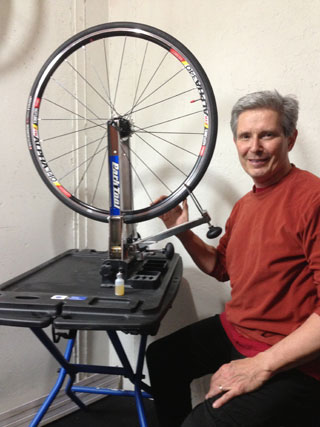 Comments below are from Dan Krane who took my wheel building school in 2012. Photo is of Dan at home admiring his work.
Comments below are from Dan Krane who took my wheel building school in 2012. Photo is of Dan at home admiring his work.
"I highly recommend Bill Mould's wheel building school for anyone interested in building wheels for the first time or honing skills if you are an experienced wheel builder. Bill is a mathematician, scientist and mentor, and takes a very methodical and exceptionally well-thought-out approach to teaching about wheel building.
I wanted to build a set of relatively light tubeless road wheels, but had never built wheels before (I am a corporate lawyer). Before I signed up for the class, Bill patiently guided me through the entire process of selecting and ordering parts that would satisfy my requirements and budget. After many telephone conversations, I ended up going with Stan's NoTubes ZTR Alpha 340 rims, Alchemy Orc rear and Elf front hubs (24/20 holes), Sapim CX-Ray bladed spokes and Sapim Polyax SILS aluminum nipples (about 1250 grams/set).
The class itself greatly exceeded my expectations. It was one-on-one instruction for the better part of two days, and Bill carefully guided me through every step of the process. He not only taught me how to build the wheels – which came out absolutely perfect – but also everything about the components, tools, the back-story on the manufactures (like Stan's and Sapim), and even some basic bike maintenance when we installed the new cassette on the rear hub. I ended up buying a bunch of tools (Bill has everything in stock) and his DVDs on bike maintenance (“Ready to Roll”) and the science behind riding faster (“Bike Better Bike Faster”), both of which I recommended as well.
If you have any interest in building wheels or just learning more about them, this class is for you."
- Dan Krane, Philadelphia, PA
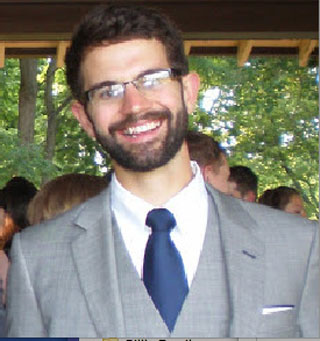 Ryan Whelpley, a mechanical engineer from the Washington DC area, built two wheels in my school using White Industries T11 hubs, Velocity A23 rims (OC in the rear), Sapim CX-Ray spokes, and Sapim Polyax SILS nipples. Ryan learned the correct lacing for a wheel followed by the careful process of tensioning it to ensure it ends up true, both laterally and radially. The wheels turned out great, and Ryan was pleased with the results.
Ryan Whelpley, a mechanical engineer from the Washington DC area, built two wheels in my school using White Industries T11 hubs, Velocity A23 rims (OC in the rear), Sapim CX-Ray spokes, and Sapim Polyax SILS nipples. Ryan learned the correct lacing for a wheel followed by the careful process of tensioning it to ensure it ends up true, both laterally and radially. The wheels turned out great, and Ryan was pleased with the results.
"I had expected that it would be a constant battle to keep the wheel true while tensioning it. I had anticipated that correcting one problem would lead to another. However, with Bill's informative and accessible instruction, that was not the case. He replaced assumptions and misconceptions with his engineer expertise applied to wheel building. Additionally, Bill's method gave me increasing independence throughout the process of building both my wheels. By the end of the class, I had a good understanding of his wheel building process and I felt confident I could repeat it. The school was a fantastic experience that exceeded my expectations. I'm delighted with the results."
- Ryan Whelpley
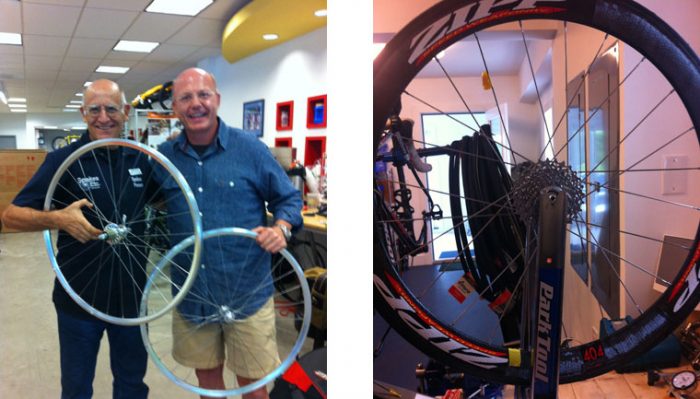 Don built up some really nice wheels using Velocity race hubs with Kinlin XR-200 rims, DT Swiss double-butted 14/15/14 gauge spokes and Sapim Polyax SILS nipples. The wheels came out perfectly! He also picked up some tools from me that are important for proper servicing of his Zipp wheels made with Sapim CX-Ray aero spokes.
Don built up some really nice wheels using Velocity race hubs with Kinlin XR-200 rims, DT Swiss double-butted 14/15/14 gauge spokes and Sapim Polyax SILS nipples. The wheels came out perfectly! He also picked up some tools from me that are important for proper servicing of his Zipp wheels made with Sapim CX-Ray aero spokes.
"Fellow Riders, don't miss taking time with Bill. True especially for those of you with a mechanical bent who want to fix your own ride and maintain your own wheels, Bill Mould is a Master you shouldn't miss spending time with. There are both too few with the knowledge and too few who can teach like Bill. The lessons stick and the also motivate you to reach for more.
I'm a 50 year old with a serious CAT III Training Schedule. I ride against myself though mostly, watching my power numbers and building fitness. I travel US and Overseas to ride for the experience, because of a bad crash separating both shoulders severely my days of real long charity or race rides are done. I enjoy a 2-3 hour aggressive ride 6-7 days a week on a 2013 Pinarello Dogma 65.1 Think 2 with QUARQ Power-Garmin and Zipp 303's or a 2007 Look 585 Ultra with Zipp 404's that have a Powertap SL+. All SAPIM CX-RAY (yes, brass nipples only now for me Bill!).
It was a need to feel comfortable fixing, maintaining, and properly cleaning my bikes myself that got me to Bill. I had changed tires and done the basics, but with torques, cranks, headsets and other things on the new carbon bikes especially, I just wasn't confident with the tools. Even things like turning the derailleur barrels the right way to get the chain movement corrected - actually this took me first to Amazon to look for ideas, found his DVD series and that got me to Bill. The confidence came in doing as instructed. Bill was so very detailed and had a way of explaining that just stuck. I live on the NJ Shore, and the cycling shop I used serviced and sold alot of beach cruisers. When I needed something fixed quickly, I not only found I was bumped to the back of the line, but also that some of the work just wasn't as careful as I would've liked.
The catalyst focus on wheels was a little unexpected. It was not so much to become a master builder, but just to maintain my wheels. On vacation, my 404's cracked on a ride down twisting roads from Ghisallo in Como, Italy at about 48 mph. I was lucky through lots of twists and turns, but it wasn't until I drove 6 hours down to D.C. Metro area to have a class with Bill that I really understood the just how precarious the problem was that rooted itself in not having the right spoke tensioning. As a result, the carbon rims cracked on the edge and separated. A costly problem resulting from something as seemingly 'small' as the right tension in the spoke. This lead me to reading more - The Art of WheelBuilding (Gerd Shraner) and The Bicycle Wheel (Jobst Brandt) - to try and learn.
Not only was the SAPIM tensioning wrong and left that way after a full 'checkup' by the local shop, I also found the local mechanic just replaced the SAPIM I needed replacing some time back with just any old spoke because he said he didn't realize I had a Powertap 2.4SL+ hub on the drive side so the spoke he thought he'd use didn't fit (!?). True. Still, then I didn't know the difference, and now I not only get it but I have much more confidence around tools, wheel building and wheel maintenance. Now I have a choice to use the local mechanic or to do it myself. I like the independence, and because of my mechanical background I welcomed the hands-on.
Let's just say surviving the Ghisallo descent motivated me most to seek a pro, and I was very lucky to find Bill Mould. I tracked him down on the internet from his DVD information, asked about doing a class with him 1:1 in the shop. Drove down and stayed over for 2 full days in a hotel to meet Bill at the shop and go to work. We built the wheelset you see in the picture. I ultimately donated it to a promising young club rider there at the shop as a way of giving back.
While websites and books have information, there is nothing that replaced hands-on knowledge. You will also find that there is an array of tools, some you might craft yourself (ie the nipple wrench from a bent spoke or the wooden wheel alignment block) that you'll learn. You'll find there's a different tensiometer, WAG or even calipers- different readings and charts. Different materials to choose when ordering let alone knowing how to get to the right size spokes with the right nipples and nipple materials. It could seem like it's very confusing if you don't have a framework and base knowledge acting as a Rosetta Stone that simplifies it all. Bill gives this knowledge in his class that allows you to learn best by doing.
Bill's a gift. Giving back generously and patiently the decades of knowledge from thousands of wheelsets is what Bill does. I thank him for it. Shortly after coming home, I fitted out my bench with tools I used in Bill's class because I wanted to become more of a independent self mechanic. I learned where to source my SAPIM spokes (wheelbuilder.com) and went through the other learning process of sizing, ordering and then tearing down-rebuilding my Zipp 404's with and without Powertap just to reinforce my lessons. When I used a new tool that I didn't in class (ie the DT Swiss Tensiometer vs the PARK Tensiometer) or when I got myself in a corner, I called and Bill answered to straighten me out, I not only rebuilt them but did so better than the condition they were in. My confidence and comfort soared. It's hard to describe, but it was like being an apprentice in the detailed artisan days. You're going to come across tools and parts you haven't used - you have to have a framework for working with them. There's a logic, a cadence to the work that you learn that serves you well even with different tools - you understand not only what you're doing, but learn why you're doing it this way over the 3 other ways you could've done it. Real learning.
I wish you all safe riding and encourage time with Bill. He is truthfully someone I will never forget. Thank you Bill. You are an Artisan, Teacher and an Gentleman of the highest order."
- D. A. Edmunds, New Jersey
